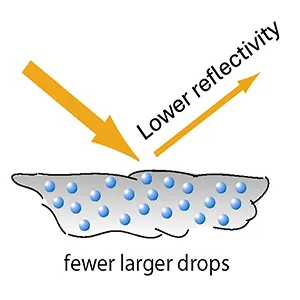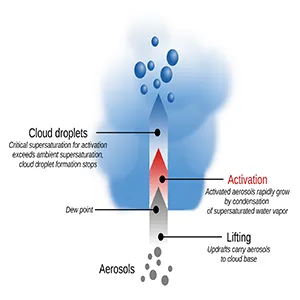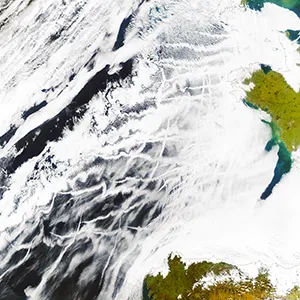
Scientists find a hidden cost of lowering air pollution called the 'clean air paradox'
Earth’s mirror is dimming over two of its largest ocean basins, and that lost shine is turning into heat. A new study finds that marine cloud reflectivity, caused by cleaner air, has dropped by roughly 2.8 percent per decade across the North Atlantic and Northeast Pacific.
Together, those regions span about one-seventh of the planet’s surface, making even small changes in brightness significant on a global scale.
The finding helps explain why recent warming has outpaced many forecasts. It points to a simple driver with complex physics: fewer air particles mean dimmer clouds and more shortwave energy reaching the sea surface.
Fading clouds, warming seas
The study was led by Dr. Knut von Salzen, a senior research scientist at the University of Washington (UW) whose work explores how tiny airborne particles and cloud microphysics shape Earth’s heat balance.
Clouds play a major cooling role by reflecting sunlight back into space – a property known as albedo – the fraction of light a surface reflects. Low clouds over cooler oceans handle much of this job.
But satellite data now reveal a subtle shift. The cloud radiative effect – the net change in energy caused by clouds – has weakened as marine clouds brightened less and covered less area.
The team zeroed in on the Northeast Pacific and North Atlantic, where ocean temperatures have risen rapidly over the past two decades.
Measurements from NASA’s CERES EBAF dataset show a steady drop in reflected shortwave radiation in these regions.
Together, these basins cover roughly 14 percent of Earth’s surface. Even a modest decline in cloud reflectivity can translate into a measurable boost in global warming.

Cleaner air, fewer cloud droplets
Airborne aerosols, tiny particles that seed cloud droplets, have declined as pollution controls tightened. With fewer particles, droplets grow larger, and clouds lose some brightness and tend to rain out sooner.
“We may be underestimating warming trends because this connection is stronger than we knew,” said Dr. von Salzen.
Two classic processes put numbers to that story. The Twomey effect, more particles make clouds brighter, weakens as air gets cleaner. The Albrecht effect, fewer particles can shorten cloud lifetime, also grows in a cleaner atmosphere.
Many Earth system models have not fully captured the observed changes. The new simulations improved accuracy by refining how particles activate into droplets and how droplet size influences drizzle and cloud cover.
Those improvements allowed the model to reproduce both the magnitude and the geographic footprint of the reflectivity drop. They also linked most of the change to aerosol reductions rather than ocean temperature shifts alone.

Clean air’s hidden cost
Global aerosol declines didn’t happen by chance. Independent analyses show sharp drops in sulfur dioxide emissions from power plants in China during the 2010s, with similar pollution cuts seen across other nations.
Yet even as the air grew cleaner, heat-trapping gases continued to rise. Long-term measurements from NOAA’s Mauna Loa Observatory show a steady increase in atmospheric carbon dioxide from 2003 to 2022 – adding to the planet’s overall heat gain.
That progress carries a trade-off. Lower particle pollution brings major health benefits but also reduces the number of cloud condensation nuclei (CCN) – the microscopic seeds that water vapor condenses on to form droplets. With fewer particles, clouds become less reflective and dissipate more easily.
“We do not want to go back in time and take away the Clean Air Act,” said Sarah Doherty, senior research scientist at UW. “But we need to understand how cleaner air changes the planet’s energy balance.”
Risky climate shortcut
Satellite observations show a clear trend – fewer shiny droplets, larger droplet sizes, and faster drizzle. Together, those shifts make marine clouds less reflective and expose darker ocean surfaces to more sunlight.
The physics form a positive feedback loop: as oceans warm, low clouds thin, allowing even more shortwave radiation to reach the surface and amplify the initial heating.
In response, some researchers are exploring marine cloud brightening (MCB) – a proposed method to restore reflectivity by spraying fine sea-salt particles into the air to seed brighter clouds.
The concept aims to mimic nature by using salt rather than industrial pollution, but the science is still evolving.
NOAA reviews highlight key unknowns, including how predictable and safe such interventions would be if tested on a large scale.

Cloud clues for future warming
Short-term forecasts may soon need to factor in dimmer clouds in cleaner air. As aerosol emissions continue to fall, the study points to a persistent push toward less reflective marine clouds over the North Atlantic and Northeast Pacific.
That insight doesn’t change the urgency of cutting greenhouse gases. But it does refine climate projections by showing how cleaner air can unmask hidden warming once offset by pollution particles.
Scientists are now watching several key indicators. One is radiative forcing, the energy imbalance that drives warming or cooling. In these ocean basins, reduced aerosols have boosted the sunlight absorbed at the surface, adding regional heat pressure.
Another is the cloud radiative effect, which tracks how much energy clouds reflect or trap. Long-term satellite records help distinguish short-lived variations from lasting changes linked to cleaner air and shifting policy.
The study is published in Nature Communications.
—–
Like what you read? Subscribe to our newsletter for engaging articles, exclusive content, and the latest updates.
Check us out on EarthSnap, a free app brought to you by Eric Ralls and Earth.com.
—–













